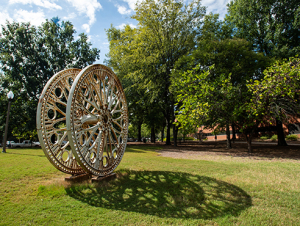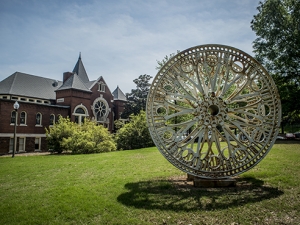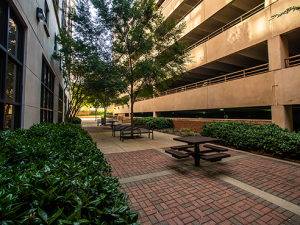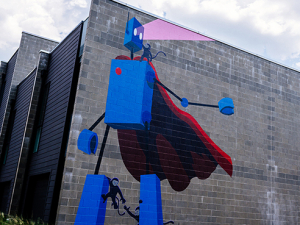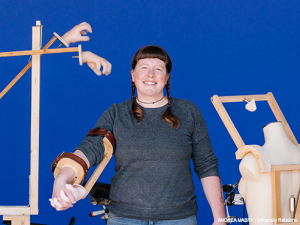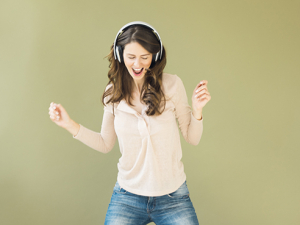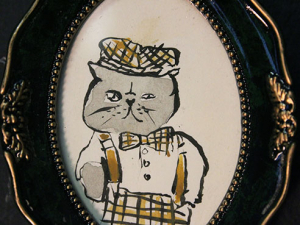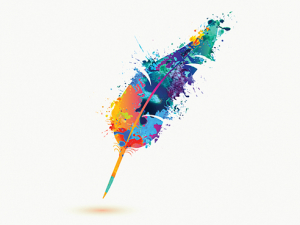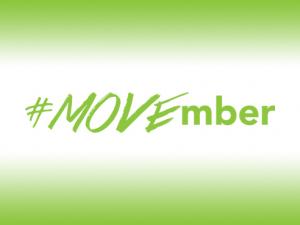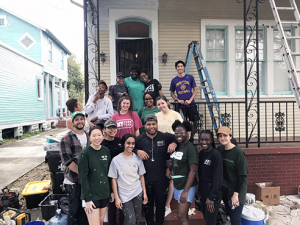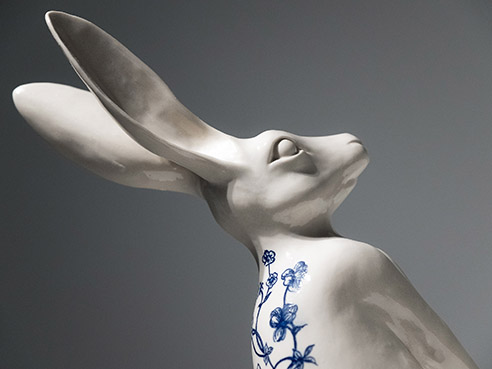 “Not to be otherwise” features a life-size bison and scores of porcelain rabbits, squirrels, birds and bees patterned with Blue Willow floral and arabesque patterns.Sculptor and Department of Art and Art History Assistant Professor Stacey Holloway’s new exhibit, “Not to be otherwise,” which was created as part of her 2017 SECAC Artist’s Fellowship, features a life-size bison and scores of porcelain rabbits, squirrels, birds and bees patterned with Blue Willow floral and arabesque patterns. It is meant to focus on interspecies bonds and consider universal experiences of alienation, isolation and longing, Holloways says.
“Not to be otherwise” features a life-size bison and scores of porcelain rabbits, squirrels, birds and bees patterned with Blue Willow floral and arabesque patterns.Sculptor and Department of Art and Art History Assistant Professor Stacey Holloway’s new exhibit, “Not to be otherwise,” which was created as part of her 2017 SECAC Artist’s Fellowship, features a life-size bison and scores of porcelain rabbits, squirrels, birds and bees patterned with Blue Willow floral and arabesque patterns. It is meant to focus on interspecies bonds and consider universal experiences of alienation, isolation and longing, Holloways says.
The giant bison, she added, is meant to represent “a bull in a china shop,” which she recalls her parents using in reference to her while growing up in the Midwest. Much of her work revolves around feeling isolated or feeling excluded, she says.
|
“I used to make work about being an outsider and having a herd being very curious about the outsider and vice versa, but now I just make work where the outsider is accepted into the herd.” |
“In my research, I found that when they actually did put a bull in a china shop, the bull was quite aware of its space,” Holloway, MFA, said in an interview with AEIVA. “An artist from New Orleans, Lee Deigaard, brought horses into an antique shop. She thought the horses would break the objects around it, but they did not. The horses were aware of the space around them. So, the idiom was proven wrong. The images that you see of the bull breaking the porcelain in the china shop — were captured because the bull was provoked. I used to make work about being an outsider and having a herd being very curious about the outsider and vice versa, but now I just make work where the outsider is accepted into the herd.”
See the exhibit through Oct. 20 in the Abroms-Engel Institute for the Visual Arts.
New material
Earlier this year, Holloway published “Warmest Regards: Letters to a Young Caster,” a collection of letters addressed to a fictional young iron-caster, written by 21 iron-casting pioneers — many of them first-generation, fine art iron-casters and significant contributors to iron-casting culture.
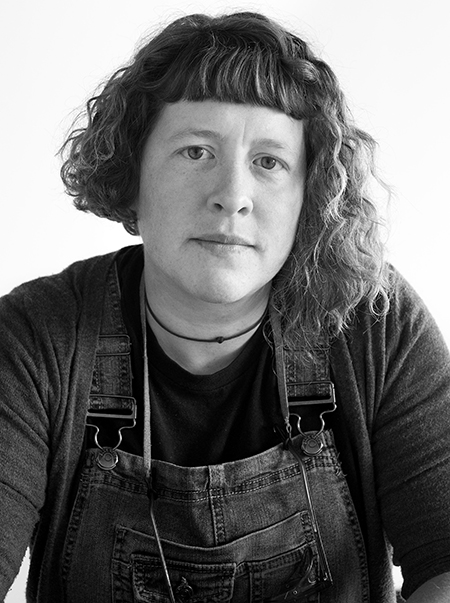 Sculptor and Department of Art and Art History Assistant Professor Stacey HollowayThough Holloway does work closely with the Sloss Metal Arts Program and partnered with other metal sculptors to publish “Warmest Regards,” she never viewed herself as a specific-media artist. She had also dabbled in porcelain slip-casting, used to make multiples of one object, so expanding from exploring the world of metal-casting to creating porcelain art isn’t as big of a jump as it seems.
Sculptor and Department of Art and Art History Assistant Professor Stacey HollowayThough Holloway does work closely with the Sloss Metal Arts Program and partnered with other metal sculptors to publish “Warmest Regards,” she never viewed herself as a specific-media artist. She had also dabbled in porcelain slip-casting, used to make multiples of one object, so expanding from exploring the world of metal-casting to creating porcelain art isn’t as big of a jump as it seems.
“Cast iron can actually be very fragile when working with thinner structures and forms, and porcelain is a pretty strong clay body when fired to maturity, so there isn’t too much of a difference,” Holloway explains, though she does note that the raw materials used for metal-casting, usually oil-based malleable materials, are much more substantial than unfired porcelain.
|
“Not to be otherwise” is open through Oct. 20 in AEIVA. Also on display is the 2018 SECAC Juried Members exhibition, which features 55 works by 43 artists across all media. |
“Not to be otherwise” opened Sept. 18 in AEIVA with a screening of the film “Alice,” a stop-motion, surreal animated retelling of Lewis Carroll’s “Alice in Wonderland,” and a tour of the exhibition with Holloway.
Also on exhibit in AEIVA is the 2018 SECAC Juried Members exhibition, which features 55 works by 43 artists across all media, including painting, photography, printmaking, design, drawing, mixed media, sculpture, video and installation.
UAB will host the annual SESAC conference here Oct. 17-20. Early registration rates are valid through Sept. 30; registration ends Oct. 8. SESAC is a non-profit organization that promotes the study and practice of the visual arts in higher education.
